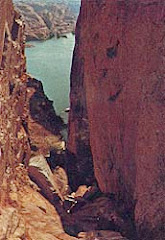Farallon Island Lighthouse
Why is this of interest? The William Robb and Helen Bell family joined with 69 LDS Immigrants lead by William Madison Wall to come to Zion. They set sail on the ship "Lucas", June 27, 1857 from Sydney, Australia. After three months and 15 days at sea, they arrived in the San Pedro, California Port, October 12, 1857. Captain J. C. Daggett was in command. The "Lucas" foundered November 1858, just a year later. An image of the "Ship Lucas" has not at this time been found... but still looking. Captain Daggett reportedly died in 1861 of "consumption".
Thirty miles west of San Francisco a collection of small, rocky islands is found. Discovered by Spaniards, the islands were given the name Los Farallones, which means small, pointed isles. The name of the islands has now been Americanized to Farallon Islands. The largest and tallest of the islands is southeast Farallon, which rises to a height of 358 feet. It was atop this island that the Farallon Island Lighthouse was constructed.
Like most of the early California lighthouses, this light was to be of the Cape Cod design, with the tower protruding through the roof of the keeper's dwelling. However, due to narrowness of the island's summit, only a tower was placed atop the peak, while the keeper's quarters was built on a large plateau on the eastern side of the island. After the tower was complete, it proved too small to house a first-order Fresnel lens, and the tower had to be torn down and rebuilt. Hauling the building supplies up the crumbling slopes was an arduous task. After staging a sit-down strike, the construction worker's pleas were answered and a seasick mule named Jack arrived on the island to help pack the supplies up the steep slope. The lighthouse was lit for the first time in December of 1855.
Even with the light, in 1858, the ship Lucas foundered on the island during dense fog, prompting the call for the establishment of a fog signal. Hartman Bache, who had supervised the construction of the lighthouse, returned to the island and proceeded to build a novel fog signal. Intrigued by a large blowhole, Bache harnessed this natural source of forced air, by placing a whistle atop a chimney constructed over the blowhole. Unfortunately, the high surf needed to power the signal did not always coincide with the periods of dense fog. In 1875, a powerful storm produced a strong surge, which blew the chimney off its foundation and ended the days of the ingenious fog signal. In the early 1880s, a more predictable steam siren was put into service on the island. The signal now required human intervention to produce the blasts of compressed air, and two Victorian duplexes were constructed near the original dwelling to house the increase in keepers, who came to the island with their families.










No comments:
Post a Comment